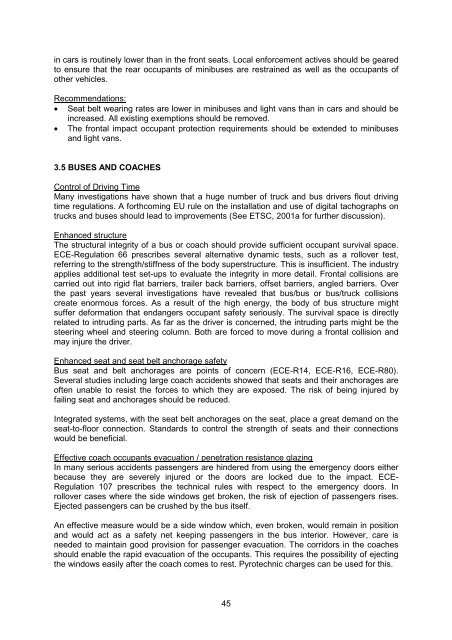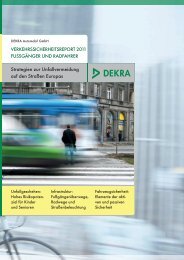PRIORITIES FOR EU MOTOR VEHICLE SAFETY DESIGN
priorities for eu motor vehicle safety design - ETSC
priorities for eu motor vehicle safety design - ETSC
You also want an ePaper? Increase the reach of your titles
YUMPU automatically turns print PDFs into web optimized ePapers that Google loves.
in cars is routinely lower than in the front seats. Local enforcement actives should be geared<br />
to ensure that the rear occupants of minibuses are restrained as well as the occupants of<br />
other vehicles.<br />
Recommendations:<br />
• Seat belt wearing rates are lower in minibuses and light vans than in cars and should be<br />
increased. All existing exemptions should be removed.<br />
• The frontal impact occupant protection requirements should be extended to minibuses<br />
and light vans.<br />
3.5 BUSES AND COACHES<br />
Control of Driving Time<br />
Many investigations have shown that a huge number of truck and bus drivers flout driving<br />
time regulations. A forthcoming <strong>EU</strong> rule on the installation and use of digital tachographs on<br />
trucks and buses should lead to improvements (See ETSC, 2001a for further discussion).<br />
Enhanced structure<br />
The structural integrity of a bus or coach should provide sufficient occupant survival space.<br />
ECE-Regulation 66 prescribes several alternative dynamic tests, such as a rollover test,<br />
referring to the strength/stiffness of the body superstructure. This is insufficient. The industry<br />
applies additional test set-ups to evaluate the integrity in more detail. Frontal collisions are<br />
carried out into rigid flat barriers, trailer back barriers, offset barriers, angled barriers. Over<br />
the past years several investigations have revealed that bus/bus or bus/truck collisions<br />
create enormous forces. As a result of the high energy, the body of bus structure might<br />
suffer deformation that endangers occupant safety seriously. The survival space is directly<br />
related to intruding parts. As far as the driver is concerned, the intruding parts might be the<br />
steering wheel and steering column. Both are forced to move during a frontal collision and<br />
may injure the driver.<br />
Enhanced seat and seat belt anchorage safety<br />
Bus seat and belt anchorages are points of concern (ECE-R14, ECE-R16, ECE-R80).<br />
Several studies including large coach accidents showed that seats and their anchorages are<br />
often unable to resist the forces to which they are exposed. The risk of being injured by<br />
failing seat and anchorages should be reduced.<br />
Integrated systems, with the seat belt anchorages on the seat, place a great demand on the<br />
seat-to-floor connection. Standards to control the strength of seats and their connections<br />
would be beneficial.<br />
Effective coach occupants evacuation / penetration resistance glazing<br />
In many serious accidents passengers are hindered from using the emergency doors either<br />
because they are severely injured or the doors are locked due to the impact. ECE-<br />
Regulation 107 prescribes the technical rules with respect to the emergency doors. In<br />
rollover cases where the side windows get broken, the risk of ejection of passengers rises.<br />
Ejected passengers can be crushed by the bus itself.<br />
An effective measure would be a side window which, even broken, would remain in position<br />
and would act as a safety net keeping passengers in the bus interior. However, care is<br />
needed to maintain good provision for passenger evacuation. The corridors in the coaches<br />
should enable the rapid evacuation of the occupants. This requires the possibility of ejecting<br />
the windows easily after the coach comes to rest. Pyrotechnic charges can be used for this.<br />
45



